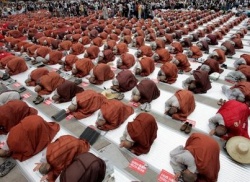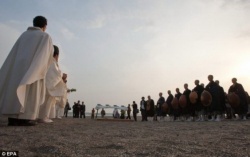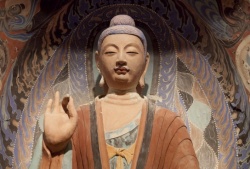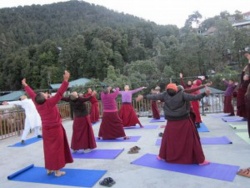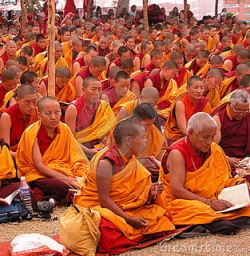Difference between revisions of "Puja"
m (Text replacement - "[[[" to "([[") |
|||
| Line 41: | Line 41: | ||
See also, [[Trikaya]]. | See also, [[Trikaya]]. | ||
| − | Not all [[deities]] must be [[worshipped]] on a regular basis, but a [[lama]] can make regular [[deity]] practice a requirement for receiving the [[transmission]] or [[empowerment]] of certain [[deities]]. When a [[teaching]] is announced with the [[phrase]] "certain [[commitments]] may be imposed" the [[student]] might like to inquire beforehand what they might entail. [[Commitments]] range from adopting a respectful [[attitude]], repeating a [[mantra]] or engaging in a formal bond or [[samaya]] | + | Not all [[deities]] must be [[worshipped]] on a regular basis, but a [[lama]] can make regular [[deity]] practice a requirement for receiving the [[transmission]] or [[empowerment]] of certain [[deities]]. When a [[teaching]] is announced with the [[phrase]] "certain [[commitments]] may be imposed" the [[student]] might like to inquire beforehand what they might entail. [[Commitments]] range from adopting a respectful [[attitude]], repeating a [[mantra]] or engaging in a formal bond or [[samaya]] ([[vow]]] to undertake a number of [[prayers]], [[mantras]], or daily [[ritual]] practices. |
[[Symbolic]] [[offerings]] to the [[Triple Gem]] are often made prior to [[Meditation]]. In front of The [[Buddha]] are placed the [[offerings]], which may be just seven [[bowls]] of [[water]] symbolising the eight hospitalities [[offered]] to a guest. Another preferred style of [[offerings]] contains [[illumination]], [[Flowers]], [[Incense]], fruit, {{Wiki|music}} and [[water]] for washing and drinking. Each represents another aspect of [[Buddhist teachings]] and also the [[five senses]]. The [[Flowers]] for example are a [[Symbol]] of [[Anicca]] (everything is [[Impermanent]]) and [[Samsara]] (the cycle of [[birth]], [[Death]] and [[Rebirth]]), due to their short [[Life]] span; unless evergreen is used to show {{Wiki|eternity}}. The {{Wiki|candles}} symbolise [[Enlightenment]] and the [[sense]] of [[sight]] while the [[Incense]] is used to show that [[Buddhist teachings]] can be spread across the [[World]] just like the {{Wiki|smell}} of the [[Incense]], which also purifies the [[air]]. As [[water]] is a necessity of [[Life]], a [[pure]] sample is also placed on the [[shrine]] to show [[respect]] and reverence for [[Life]]. To show the [[interdependence]] of all things and [[Gratitude]] for that fruit is offered—also as a [[Symbol]] of {{Wiki|taste}}. A [[Bell]] is used to indicate when to begin and end [[puja]] and to stimulate hearing but also demonstrates the [[belief]] of [[cause and effect]] and [[Karma]]. It stimulates hearing and is placed on a [[Lotus]] shaped cushion once again symbolising [[Enlightenment]] and the cycle of [[Rebirth]], as it [[Flowers]] and [[seeds]] at the same [[time]]. | [[Symbolic]] [[offerings]] to the [[Triple Gem]] are often made prior to [[Meditation]]. In front of The [[Buddha]] are placed the [[offerings]], which may be just seven [[bowls]] of [[water]] symbolising the eight hospitalities [[offered]] to a guest. Another preferred style of [[offerings]] contains [[illumination]], [[Flowers]], [[Incense]], fruit, {{Wiki|music}} and [[water]] for washing and drinking. Each represents another aspect of [[Buddhist teachings]] and also the [[five senses]]. The [[Flowers]] for example are a [[Symbol]] of [[Anicca]] (everything is [[Impermanent]]) and [[Samsara]] (the cycle of [[birth]], [[Death]] and [[Rebirth]]), due to their short [[Life]] span; unless evergreen is used to show {{Wiki|eternity}}. The {{Wiki|candles}} symbolise [[Enlightenment]] and the [[sense]] of [[sight]] while the [[Incense]] is used to show that [[Buddhist teachings]] can be spread across the [[World]] just like the {{Wiki|smell}} of the [[Incense]], which also purifies the [[air]]. As [[water]] is a necessity of [[Life]], a [[pure]] sample is also placed on the [[shrine]] to show [[respect]] and reverence for [[Life]]. To show the [[interdependence]] of all things and [[Gratitude]] for that fruit is offered—also as a [[Symbol]] of {{Wiki|taste}}. A [[Bell]] is used to indicate when to begin and end [[puja]] and to stimulate hearing but also demonstrates the [[belief]] of [[cause and effect]] and [[Karma]]. It stimulates hearing and is placed on a [[Lotus]] shaped cushion once again symbolising [[Enlightenment]] and the cycle of [[Rebirth]], as it [[Flowers]] and [[seeds]] at the same [[time]]. | ||
Revision as of 22:42, 3 April 2016
In Buddhism, puja (Sanskrit & Pali: pūjā) are expressions of "honour, worship and devotional attention." Acts of puja include bowing, Making Offerings and Chanting. These devotional acts are generally performed daily at home (either in the morning or evening or both) as well as during communal festivals and Uposatha days at a temple.
Etymology
The origin of the word Puja lies in the Dravidian languages. Two possible Tamil roots have been suggested: Poosai "to smear with something" and Poochei "to do with Flowers".
Bows
In the context of puja, bowing refers to the act of raising one's hands together (Anjali) and lowering one's head in a gesture of homage and humility. As a devotional act, one bows to The Buddha's likeness in a statue, to a Stupa (a Pagoda that enshrines bodily Relics of the Buddha) or to the Bodhi tree. Traditionally, one also bows to parents, teachers, the elderly and monastics.
When bowing before a sacred object such as a Buddha statue, one usually bows three times, recalling with the first bow The Buddha, then the Dhamma and then The Sangha. One may simply offer a head-lowered bow with palms-together hands held in front of one's Heart or forehead, or one may move one's hands in a single flowing movement from the head to the lips to the chest (representing Thought, speech and Body). More formally, one may bow with a series of head-to-floor prostrations.
Offerings
The offerings directed to deities, Buddhas, or Bodhisattvas are of a different nature; these donations are made in order to create connections with them. The Sanskrit word for offering is puja meaning to please.
Offerings please the Buddhas and Bodhisattvas, not because they are pleased to receive gifts, but because they delight in the virtue of the givers, which is determined by the quality of their motivation in making the offering. Offerings need not even be material. Milarepa offered his spiritual practice, his most cherished attribute. The best offerings are of virtuous accomplishments. Thus, the offering of religious practice is what most pleases the deities and creates a bond between them and the practitioner, which provides a basis for his/her further development.
Several factors determine the quality of an offering. Prominent is the giver's motivation, though the status of the recipient and the nature of the offering also contribute. The giver acquires the greatest merit when he/she is motivated by a wish to attain enlightenment for the sake of all sentient beings. It is much less if he/she aspires for his/her own enlightenment alone and even less if he/she wishes merely to obtain a good rebirth in his/her next life. The poorest motivation is the wish to gain some benefits in this lifetime, such as wealth and a long life, or to be completely mundane in seeking a reputation for generosity.
The status of the recipient is an important factor. The merit gained by making an offering with absolutely pure motivation to a Buddha is immeasurable. Since images and other manifestations of the Buddhas and Bodhisattvas are to be regarded as no different from them in nature, making offerings such as are made to the mandala deities in the consecration rituals is equivalent to making offerings to the Buddhas.
The Buddhas are exalted objects of offering because they are the ultimate source of refuge, not because they will snatch us out of cyclic existence, but because the teachings they demonstrate enable us to do so ourselves. One's own lama or teacher is also an exalted object of offering, because it is due to his personal kindness and guidance that one can make any progress on the path of development for the benefit of all sentient beings.
Nevertheless, since pure motivation is so important, a gift made with a very pure motivation to a needy person is also very meritorious. One can reflect that this needy person has at sometime been one's own kind mother or consider the fact that one depends on others to attain enlightenment, for without them one would have no opportunity to practice giving, ethics and forbearance, which are essential in the quest for Buddhahood. Thus it could be said that the merit obtained from making a modest gift to a needy person with an exalted motivation is far greater than one made to a Buddha with a poor motivation.
Whatever is offered should always have been honestly obtained, for a wrongly acquired object severely detracts from the wholesome quality of giving it. Offerings should always be of the best one has. Food offered to the Buddhas should not be bad or rotten on the pretext that no one will eat it. It is good to offer one's own food before eating it. Since the main purpose of making offerings is to reduce avarice, one should do so without a trace of regret. The Buddha recommended that avaricious people should initially accustom their minds to sharing by giving something from one hand to the other.
Honoring the Deities
Tantric Buddhism uses the skillful means of ritual as a form of training. The methods include self-purification, the development of virtues ("perfections") such as humility and generosity, and a devotion to forms ie. deity worship and the commitment to regularly attend to unseen beings. While deities are ultimately understood to emerge from, and to return to Emptiness, they are also viewed as having existence.
The Heart Sutra encapsulates the fundamental principle behind what some might find to be a contradiction in terms.
See also, Trikaya.
Not all deities must be worshipped on a regular basis, but a lama can make regular deity practice a requirement for receiving the transmission or empowerment of certain deities. When a teaching is announced with the phrase "certain commitments may be imposed" the student might like to inquire beforehand what they might entail. Commitments range from adopting a respectful attitude, repeating a mantra or engaging in a formal bond or samaya (vow] to undertake a number of prayers, mantras, or daily ritual practices.
Symbolic offerings to the Triple Gem are often made prior to Meditation. In front of The Buddha are placed the offerings, which may be just seven bowls of water symbolising the eight hospitalities offered to a guest. Another preferred style of offerings contains illumination, Flowers, Incense, fruit, music and water for washing and drinking. Each represents another aspect of Buddhist teachings and also the five senses. The Flowers for example are a Symbol of Anicca (everything is Impermanent) and Samsara (the cycle of birth, Death and Rebirth), due to their short Life span; unless evergreen is used to show eternity. The candles symbolise Enlightenment and the sense of sight while the Incense is used to show that Buddhist teachings can be spread across the World just like the smell of the Incense, which also purifies the air. As water is a necessity of Life, a pure sample is also placed on the shrine to show respect and reverence for Life. To show the interdependence of all things and Gratitude for that fruit is offered—also as a Symbol of taste. A Bell is used to indicate when to begin and end puja and to stimulate hearing but also demonstrates the belief of cause and effect and Karma. It stimulates hearing and is placed on a Lotus shaped cushion once again symbolising Enlightenment and the cycle of Rebirth, as it Flowers and seeds at the same time.
Chanting
Typically performed in traditional languages, such as Pali or Tibetan, Buddhist chants assist in the memorization of early canonical formulae and imbue participants with a sense of solemnity and tranquillity.
Puja in daily practice
Personal devotion usually entails first making an Offering to a sacred object (such as placing Flowers or fruits before a Buddha image). When making the Offering, one bows while reciting traditional phrases identifying the Offering. Next, the devotee either bows or prostrates three times to the Triple Gem. While continuing to kneel with palms-together hands held before the Heart, the devotee then intones various chants typically starting with paying homage to The Buddha, taking the three refuges and undertaking The Five Precepts.
Canonical references
In Buddhism's earliest texts, the Pali Canon, honoring those "worthy" (Pali: Arahant) of honor is considered one of the "highest Blessings," as reflected in the following words attributed to The Buddha (in English and Pali):
Mangala Sutta
With fools no company keeping,
With the wise ever consorting,
To the worthy homage paying:
This, the Highest Blessing....
Asevanā ca bālānam
Panditānañ ca sevanā
pūjā ca pūjanīyānam
etam mangalam-uttamam....
